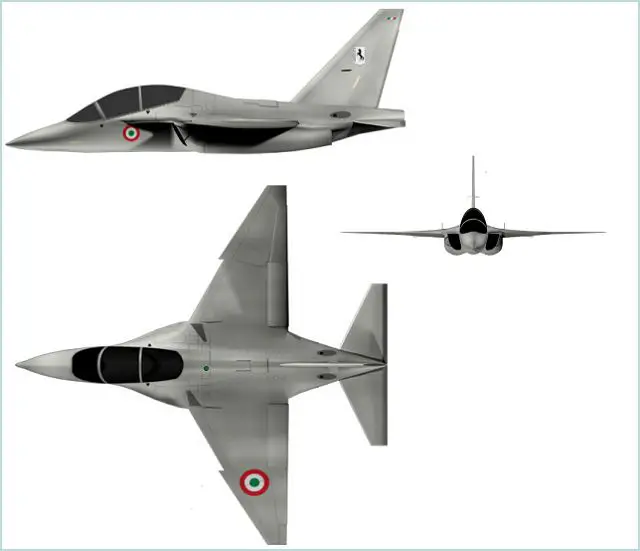M-346
| a | ||||||||||||||||||||||
|
M-346 trainer aircraft
|
||||||||||||||||||||||
 |
||||||||||||||||||||||
|
|
||||||||||||||||||||||
|
The Alenia Aermacchi M-346 Master is a military trainer aircraft. The first prototype rolled out on 7 June 2003 and flew for the first time on 15 July 2004. The first low-rate initial production (LRIP) aircraft made its maiden flight in July 2008. The twin-turbofan M-346 is the most advanced lead-in fighter trainer flying today. With its fully digital flight controls and avionics, together with carefree handling and high AOA maneuvering, the M-346 is fully representative of new generation fighters. By downloading a significant proportion of the training syllabus, the M-346 is also extremely cost-effective. It has been ordered by the Air Forces of Italy and Singapore. The M-346 has been selected by the Italian Air Force as their next advanced jet trainer. The M-346 is currently competing around the world for future Advanced Jet Training (AJT) programs. In February 2012, the Italian M-346 trainer aircraft of Alenia Aermacchi (a Finmeccanica company) has been selected by Israel’s Ministry of Defence to train its Air Force pilots. |
||||||||||||||||||||||
| Variants | ||||||||||||||||||||||
|
- No variants at this time
|
||||||||||||||||||||||
| Technical Data | ||||||||||||||||||||||
| Design | ||||||||||||||||||||||
|
The M-346’s vortex lift aerodynamics, variable camber wing, near 1:1 thrust to weight rations, and fly-by-wire flight control system allow the aircraft to remain fully controllable at angles of attack up to 40° and ensure maneuverability, performance and flying qualities close to that of a front line fighter. The M-346 is designed for training combat pilots for front line fighter aircraft. It is capable of transonic flight without using an afterburner, which is designed to reduce acquisition and operating costs. Two engines and triple-quadruple redundant systems enhance reliability.
|
||||||||||||||||||||||
| Avionics | ||||||||||||||||||||||
|
The latest generation of avionics, state-of-the-art pilotvehicle interface and the in-flight capability to simulate tactical scenarios, sensors and weapons immerse the pilots in a realistic and complex training environment, making the M-346 the ideal platform for future Integrated Training Systems for combat aircraft such as the Eurofighter, F-22 and F-35.
The M-346 equipped with advanced helmet-mounted display systems completed its maiden flight in May 2010. The avionics architecture is based on a dual-redundant MIL-STD-1553B digital data bus which has capacity for additional systems. The communication suite includes a VHF/UHF transceiver and an information friend of foe (IFF) transponder. The navigation suite includes a laser gyro inertial navigation system with an embedded GPS receiver, and a tactical air navigation (TACAN) and VHF omnidirectional radio ranging (VOR/IIS/MB). The flight control system (FCS) is a full authority digital fly-by-wire quadruple-redundant system, which includes four BAE Systems Italia flight control computers. |
||||||||||||||||||||||
| Propulsion | ||||||||||||||||||||||
|
The M-346 trainer aircraft is powered by two Honeywell F124 engines, and uses a digital flight control system by Teleavio/Marconi in collaboration with BAE Systems, Dowty and Microtecnica for actuators. The M-346 can climb at the rate of 127m/s. The maximum and cruise speed of the aircraft are 1,092km/h and 1,059km/h respectively. The range and service ceiling of the M-346 are 2,590km and 13,700m respectively.
|
||||||||||||||||||||||
| Armament | ||||||||||||||||||||||
|
Armaments are carried on nine external store stations, six of which are underwing, equipped with 450 kg class ejector release units, and two wingtip stations for air-to-air missiles. The under-fuselage station carries avionics pods or a 300 l conformal fuel tank. Provisions provided for a total of 9 pylon stations (2× wingtip, 1× under-fuselage plus 6× underwing), capable of mounting up to 3,000 kilograms (6,600 lb) of external payload and up to 3× 630 litres (140 imp gal; 170 US gal) external drop tanks (only pylon stations 4, 5, 6 are wet-plumbed)
|
||||||||||||||||||||||
| Specifications | ||||||||||||||||||||||
|
||||||||||||||||||||||
 |
||||||||||||||||||||||
|
||||||||||||||||||||||































